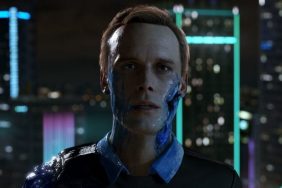Quantic Dream's David Cage, throughout his GDC talk "Technologies to Support Emotion", occasionally pops his microphone. It sounds like a bass speaker crashing into the pavement from three-stories high, but his lecture still kept his audience engaged. More than just a wrapper for his Kara tech demo, he describes a fairly comprehensive history of virtual actors at Quantic Dream, while taking a brief look at contemporary cinema and where games are going.
Cage highlights the holy grail of virtual performances as full performance capture, where the face, body, and voice are captured simultaneously. He uses Avatar and Tin-Tin as examples but talks about how these aren't feasable for a developer like Quantic Dream, since the video capture on the face is used as reference rather than direct capture. Having animators recreate exact facial models from video reference is too expensive.
This means that traditionally, performance capture for games has been done with what Cage identifies as Split Performance Capture. This where the body and face are captured separately. Cage doesn't say it, but the elephant in the room is that Split performance capture has come a long way and was notably used for the expressive faces in L.A. Noire.
One of the advantages that Cage doesn't mention about Split Performance capture is that it can allow the performer's face to be captured in minute detail with mutiple cameras, which allows for a greater degree of realism in expression, catching ticks and jerks of the face in places markers can't define. It has a problem, though, in that the faces and body may not always match, causing the extremely expressive head to look like it’s floating on the end of a neck, unchanged by the body’s actions. This may be one reason why Cage is so keen on Full Performance.
For the virtual David Bowie in their 1999 game Omikron, Quantic Dream created lip sync by using phonems (the shapes the mouth uses to make syllables) that were controlled by a midi-keyboard, where a 'face musician' was playing the mouth sync to the dialogue. Indigo Prophecy (2005) took things a step further with a puppeteer doing the phonems with one hand and the emotions with the other. With The Casting (2006) and Heavy Rain (2010), they were doing true Split Performance Capture.
Cage then shows Kara, their tech demo using Full Performance Capture; in addition to the 65 cameras, 90 markers were used for the body and 90 for the face. Kara stumbles a little bit through the uncanny valley, but a perfect simulation here isn't really the point of the demo, something that Cage was free to acknowledge.
The point is that the demo runs in real-time on the PS3, with merely the first iteration of their new engine, and the performance is 'almost raw', meaning that it's almost completely based on just the data received from the performance. The skin growth and hair growth effects are achieved through a script playing in real-time. If that isn't enough, they can even capture multiple characters at the same time. Current generation technology is amazing, no?
Cage quickly shows how they used other actors for the French, German, and Japanese parts of the performance, showing the ability of the Engine to "Retarget" other performances to the same model. He talks about their "Direct-to-Engine" pipeline which gives developers about a 24-hour turnaround, and mentions their cinematic "close-up lighting editor" that changes the lighting in the same way that films do. The need for full motion performance, he claims, is so that actors can properly embody the whole characters.
What's most astounding is that Cage says that this demo is only a year old. The engine shown in the demo, v1, has about 50 percent of the ability of their current one, v3. The point is not a tool that creates an amazing end-product, but one that gets the artists close enough that all they need to do is the fine detail work. It's an expeditor. All things considered, it seems that Quantic Dream is on the right track on delivering even more realistic performances in games in the future.







